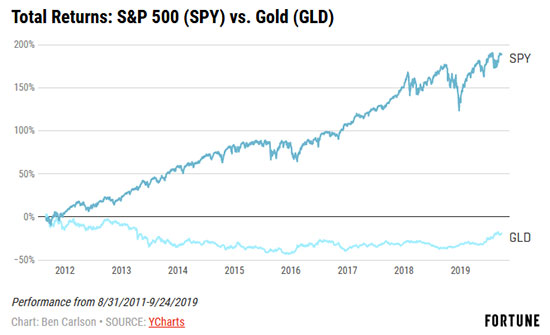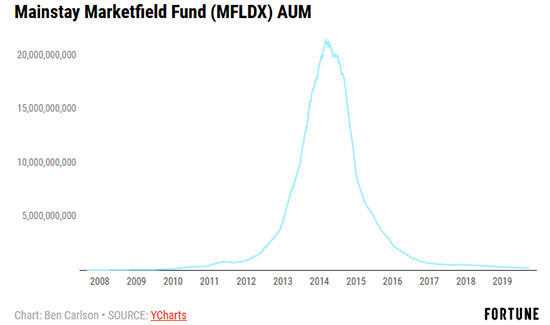投資基金要當(dāng)心:過于看重業(yè)績可能導(dǎo)致巨大虧損

|
2011年8月,,SPDR Gold Shares ETF (GLD)短暫超越S&P 500 SPDR ETF (SPY),成為資產(chǎn)最多的交易所交易基金,。然而自那以后,,這兩大基金的投資業(yè)績卻有天壤之別。 |
In August 2011, the SPDR Gold Shares ETF (GLD) briefly surpassed the S&P 500 SPDR ETF (SPY) as the largest exchange-traded fund in terms of assets. Since then, the investment performance of these two funds are night and day. |

|
從2011年8月至今,,S&P 500的總體回報(bào)約有190%的漲幅,,而GLD的總體回報(bào)則比那個(gè)夏天的最高點(diǎn)低了近20%,。成為全球第一的交易所交易基金本身沒有什么魔咒,,但這個(gè)榮譽(yù)卻讓GLD的資產(chǎn)嚴(yán)重流失。 |
The S&P 500 is up roughly 190% in total since the end of August 2011 while gold remains nearly 20% below its high watermark from that summer. There’s nothing magical about becoming the biggest ETF in the world but the aftermath of this honor was none too kind to the assets in GLD: |

|
GLD的管理資產(chǎn)額從2011年夏末的超過770億美元一路銳減到2015年年底的210億美元,。這一情況的有趣之處是,,管理資產(chǎn)額比相關(guān)基金的業(yè)績下滑更為嚴(yán)重。 GLD的管理資產(chǎn)在四年多一點(diǎn)的時(shí)間里縮水了72%以上,,而GLD本身的業(yè)績只下滑了43%,?;饍r(jià)格的跌幅已然相當(dāng)巨大,但資金外流的嚴(yán)重程度還要更甚,。 在GLD成為全球最大交易所交易基金的過程中,,情況恰恰相反。從2007年到2011年8月,,GLD的價(jià)格漲幅超過180%,,但同期的資產(chǎn)卻增長了近700%。其部分原因可能在于金融危機(jī)導(dǎo)致對(duì)沖系統(tǒng)性風(fēng)險(xiǎn)猛增,,黃金成為許多人青睞的替代品,。但很明顯,追求業(yè)績也在從中起到了推波助瀾的作用,。 基金表現(xiàn)良好,,資產(chǎn)就會(huì)蜂擁涌入?;鹨坏╋@出頹勢,,資產(chǎn)則會(huì)迅速逃離。這在基金領(lǐng)域不是什么新鮮事,。過去一直有追求業(yè)績的人,,未來也同樣如此。 SPY如今以超過2,700億美元的資產(chǎn)獲得了最大交易所交易基金的稱號(hào),。令人驚訝的是,,從2011年被GLD短暫超越至今,SPY的資產(chǎn)增長都來自于市場收益,,而不是投資者的現(xiàn)金流,。SPY的管理資產(chǎn)額自2011年8月至今僅有194%的增長,與基金總回報(bào)的增長率190%幾乎持平,。 指數(shù)基金和交易所交易基金無法避免追求業(yè)績的影響,,但更加非傳統(tǒng)的資產(chǎn)類別和策略似乎會(huì)更多地面臨投資者對(duì)業(yè)績的追求。 自2008年股市崩盤之后,,投資者迫切想要尋求能夠減少股市風(fēng)險(xiǎn)或擁有不相干的較高預(yù)期回報(bào)的其他投資手段,。流動(dòng)資產(chǎn)領(lǐng)域幾乎沒有什么基金具備這樣的前景,但卻有一家基金由于業(yè)績突出得到了投資者的關(guān)注,。 Mainstay Marketfield Fund (MFLDX) 的投資收益相當(dāng)豐厚,,自2009年到2014年第一季度的回報(bào)率超過100%。這一時(shí)期,,SPY的漲幅超過130%,。不過另類基金可以切換資產(chǎn)類別,也有能力賣空證券,,這保持了對(duì)投資者巨額資金的吸引,。 MFLDX的資產(chǎn)從起初2009年的3,400萬美元暴增到2014年年初的超過210億美元,。盡管基金業(yè)績僅僅翻了一倍,資產(chǎn)卻增長了600倍,。沃倫·巴菲特曾經(jīng)表示:“規(guī)模是出色業(yè)績的大敵”,,這句話對(duì)MFLDX同樣適用。 從2014年第一季度起,,MFLDX變得黯淡無光,。到目前為止,美國股市上漲了近80%,,而它的跌幅卻超過11%,。資金撤離了這只基金,就和它當(dāng)初涌入時(shí)一樣迅速,。它的管理資產(chǎn)如今不足2億美元,,與2014年的高點(diǎn)相比跌幅達(dá)99%。 |
From a high of more than $77 billion in that late-summer of 2011, assets under management (AUM) in GLD fell all the way to $21 billion by the end of 2015. What’s interesting in this scenario is how much more AUM fell than performance in the underlying fund. Assets in GLD fell more than 72% in a little over 4 years while performance in GLD itself was only down 43%. That’s a fairly substantial crash in price but an even more substantial outflow in terms of assets. The flipside was true in the run-up to becoming the world’s largest ETF. From 2007 through August 2011, GLD was up more than 180%. But assets in the fund grew nearly 700% in that time. Some of this could have been due to the fact that the financial crisis created a flight to hedge systemic risk, of which gold is a favored proxy for many. But it’s clear there was also an element of performance chasing going on as well. When the fund performed well, assets poured in. And then when the fund performed poorly, assets fled. This is nothing new in the fund space. There have always been performance chasers and there will always be performance chasers. SPY now wears the crown as the largest ETF with more than $270 billion in assets. Surprisingly, the growth in assets for SPY since GLD passed it briefly in 2011 has come from market gains, not flows from investors. Assets under management in SPY have grown just shy of 194% since August 2011, not much more than the close to 190% total returns in the fund. Index funds and ETFs aren’t immune to performance chasing but the more non-traditional asset classes and strategies tend to see more performance chasing from investors. Following the market crash in 2008, investors were eager for alternative investments that would either hedge the stock market or offer an uncorrelated return stream with high expected returns. Few funds in the liquid alt space delivered on these promises but one fund did gain investor attention because of its performance. The Mainstay Marketfield Fund (MFLDX) saw strong returns, delivering a return of more than 100% from 2009 through the first quarter of 2014. The S&P 500 was up more than 130% in this time, but the fact that an alternative fund that switches between a number of asset classes and has the ability to short securities was able to keep up attracted huge inflows from investors. Assets in MFLDX exploded from just $34 million at the outset of 2009 to more than $21 billion by early-2014. So while fund performance merely doubled, assets were up 60,000%. Warren Buffett once said, “Size is the enemy of outperformance,” and the Marketfield Fund was no different. Since the first quarter of 2014, MFLDX has gone nowhere, losing a total of more than 11% up to now. U.S. stocks are up nearly 80% in this time. The fast money that poured into this fund fled just as fast as it came in. Assets are now under $200 million, down 99% from the highs in 2014. |

|
這就是一個(gè)效果驚人的追求業(yè)績的案例,。那些在金融危機(jī)中受到傷害,,并在尋找瘋狂股市替代品的投資者可能是罪魁禍?zhǔn)住J袌鲎兓脽o常,,而投資者也是如此,。 追求業(yè)績的歷史悠久,這類行為永遠(yuǎn)不會(huì)消亡,。任何時(shí)候都會(huì)有一些表現(xiàn)突出的基金或深?yuàn)W的策略,。不幸的是,大多數(shù)投資者往往在它們的強(qiáng)勁表現(xiàn)落幕之后才開始注資,。(財(cái)富中文網(wǎng)) 本文作者是注冊(cè)金融分析師本·卡爾森(Ben Carlson),,他是里薩茲財(cái)富管理公司(Ritholtz Wealth Management)機(jī)構(gòu)資產(chǎn)管理部門的主任。 譯者:嚴(yán)匡正 |
This was a performance chase of epic proportions, most likely caused by investors who were still somewhat scarred from the financial crisis and in search of an alternative to the stock market’s crazy ways. The market can be fickle but so are investors. Performance chasing is as old as the hills so this type of behavior is never going away. There will always be certain funds or esoteric strategies that do better than others at times. Unfortunately, most investors tend to put their money into these strategies only after they’ve already experienced strong outperformance. Ben Carlson, CFA is the Director of Institutional Asset Management at Ritholtz Wealth Management. |













